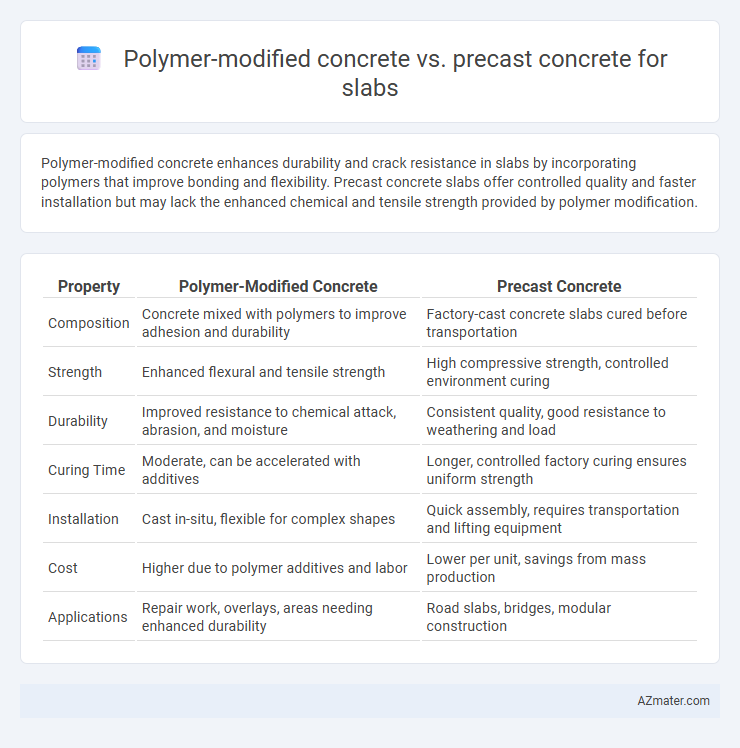Polymer-modified concrete enhances durability and crack resistance in slabs by incorporating polymers that improve bonding and flexibility. Precast concrete slabs offer controlled quality and faster installation but may lack the enhanced chemical and tensile strength provided by polymer modification.
Table of Comparison
| Property | Polymer-Modified Concrete | Precast Concrete |
|---|---|---|
| Composition | Concrete mixed with polymers to improve adhesion and durability | Factory-cast concrete slabs cured before transportation |
| Strength | Enhanced flexural and tensile strength | High compressive strength, controlled environment curing |
| Durability | Improved resistance to chemical attack, abrasion, and moisture | Consistent quality, good resistance to weathering and load |
| Curing Time | Moderate, can be accelerated with additives | Longer, controlled factory curing ensures uniform strength |
| Installation | Cast in-situ, flexible for complex shapes | Quick assembly, requires transportation and lifting equipment |
| Cost | Higher due to polymer additives and labor | Lower per unit, savings from mass production |
| Applications | Repair work, overlays, areas needing enhanced durability | Road slabs, bridges, modular construction |
Introduction to Modern Concrete Technologies
Polymer-modified concrete enhances traditional concrete by incorporating polymers that improve adhesion, durability, and resistance to chemicals, making it ideal for slabs exposed to harsh environments. Precast concrete offers factory-made components with controlled quality, faster installation, and reduced onsite labor, suitable for standardized slab applications. Both technologies reflect advancements in modern concrete, optimizing performance and efficiency in construction projects.
Defining Polymer-Modified Concrete
Polymer-modified concrete (PMC) is a composite material enhanced with polymer additives, improving its adhesion, durability, and resistance to cracking compared to conventional concrete. Unlike precast concrete, which is manufactured and cured in controlled factory conditions before transportation, PMC is typically mixed and applied on-site, allowing better bonding with existing structures and enhanced flexibility in slab applications. These polymer modifications result in superior tensile strength, reduced permeability, and increased chemical resistance, making PMC ideal for slabs exposed to harsh environments or heavy traffic.
What is Precast Concrete?
Precast concrete consists of concrete elements that are cast and cured in a controlled factory environment before being transported to the construction site for assembly. This method ensures high quality, uniformity, and faster installation compared to traditional on-site casting. Its inherent strength and durability make precast concrete especially suitable for slabs requiring precise dimensions and early load-bearing capacity.
Material Composition Differences
Polymer-modified concrete incorporates polymers such as latex, epoxy, or acrylics to enhance bonding, flexibility, and durability, differing from precast concrete, which relies on standard cement, aggregates, and reinforcement in factory-controlled conditions. The polymer additives in polymer-modified concrete improve resistance to cracking, chemical exposure, and water ingress, making it suitable for demanding slab applications requiring enhanced performance. Precast concrete slabs, however, benefit from consistent quality, controlled curing, and rapid installation, but lack the enhanced chemical and flexibility properties provided by polymer modification.
Strength and Durability Comparison
Polymer-modified concrete offers enhanced tensile strength and increased chemical resistance compared to conventional precast concrete slabs, making it ideal for high-stress applications. Precast concrete slabs provide consistent compressive strength and superior quality control due to factory fabrication, ensuring durability under variable environmental conditions. While polymer modification improves flexibility and crack resistance, precast concrete excels in long-term load-bearing stability and maintenance efficiency.
Installation and Construction Techniques
Polymer-modified concrete offers enhanced adhesion and flexibility, allowing faster curing and easier on-site adjustments during slab installation compared to traditional methods. Precast concrete slabs are manufactured off-site under controlled conditions, ensuring consistent quality and reducing onsite labor and construction time significantly. Installation of precast slabs involves precise lifting and placement with cranes, minimizing weather delays, while polymer-modified concrete requires proper surface preparation and curing protocols to maximize performance.
Cost Analysis: Polymer-Modified vs. Precast Concrete
Polymer-modified concrete typically incurs higher initial material costs due to the inclusion of polymers enhancing durability and flexibility, but it offers long-term savings by reducing maintenance and repair expenses. Precast concrete slabs usually present lower upfront installation costs and faster construction times, benefiting projects with tight schedules and standardized designs. Analyzing total cost of ownership reveals polymer-modified concrete's advantage in longevity and performance, whereas precast concrete favors projects prioritizing immediate budget constraints and speed.
Performance in Different Environmental Conditions
Polymer-modified concrete exhibits superior durability and resistance to chemical attacks, freeze-thaw cycles, and moisture penetration compared to precast concrete, making it ideal for extreme environmental conditions. Precast concrete slabs offer consistent quality and controlled curing but may require additional protective coatings to perform well in highly corrosive or wet environments. The enhanced bonding properties in polymer-modified concrete contribute to improved tensile strength and reduced permeability, ensuring better long-term performance in fluctuating temperatures and aggressive weather exposure.
Sustainability and Longevity Factors
Polymer-modified concrete enhances sustainability and longevity in slab construction by improving resistance to chemical attacks, reducing permeability, and extending service life, which lowers maintenance and replacement frequency. Precast concrete slabs offer environmental benefits through controlled factory production, reducing waste and energy consumption, while providing consistent durability and faster installation that minimizes on-site disruptions. Both materials contribute to sustainable construction, but polymer modifications specifically target improved durability against harsh conditions, whereas precast concrete emphasizes resource efficiency and quality control.
Selecting the Best Concrete Solution for Slab Projects
Polymer-modified concrete enhances slab durability and chemical resistance by incorporating polymer additives that improve bonding and flexibility, making it ideal for heavy-duty or corrosive environments. Precast concrete slabs, manufactured under controlled conditions, offer superior quality, faster installation, and reduced on-site labor costs, suitable for large-scale or repeatable projects. Selecting the best concrete solution depends on project-specific factors such as load requirements, environmental exposure, installation timeline, and budget constraints.

Infographic: Polymer-modified concrete vs Precast concrete for Slab
 azmater.com
azmater.com